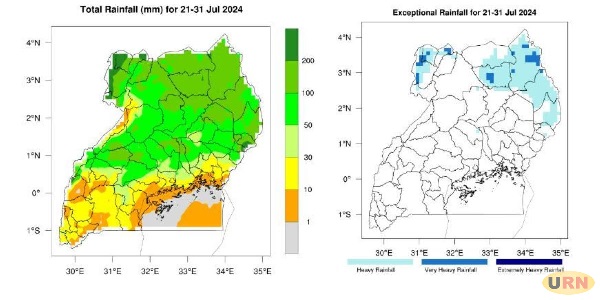
Entebbe, Uganda | THE INDEPENDENT | The Uganda National Meteorological Authority (UNMA) is advising farmers to proceed cautiously and avoid being lured by current rain into early planting of seasonal crops.
Throughout much of this month (July), the unusual weather patterns have sparked concerns among farming communities. Traditionally, in the southern sector, July—locally referred to as “Kasambula”—is typically associated with dry weather, and preparation of land after the June harvest season.
However, this year has seen abnormal rainfall, contrary to UNMA’s earlier forecasts issued in June predicting a dry season in the southern regions, including the south western areas, central region, Lake Victoria basin, and parts of the eastern region.
Yusufu Nsubuga, a meteorologist at UNMA, points out that changes in weather patterns have been attributed to southern hemispheric systems shifting the rain belt away from the northern sector.
The meteorologists had forecasted that only the northern sector would receive above-normal rains during this period. Nsubuga observed the possibility of some rainfall activity in the southern sector over the next ten days (up to the end of July).
However, he cautioned that despite the current lower position of the rain belt due to prevailing conditions, this pattern could shift, leading to the onset of the expected dry season across the southern sector in August.
He said farmers in the southern part of the country, including the southwest, central region, and the Lake Victoria basin, who are cultivating fast-growing crops like vegetables, should harvest water from the current rains to use for irrigation at times when the rains stop.
For those growing seasonal crops, Nsubuga advises patience, recommending that they wait for the normal rain season, forecasted to begin towards the end of September with precipitation levels ranging from near-average to average.
Despite the advisory, several farmers in the central and southwestern regions have already begun planting seasonal crops such as maize. Using their local knowledge, some farmers like Alice Namukasa recognize the risk but express concerns that waiting until the normal planting season may coincide with the cessation of rains.
“I’m worried that if we wait for the normal planting season, the rains might have already ended by then. Weather patterns are changing, and there’s a chance the first rain season could blend into the dry season,” expressed Namukasa, reflecting on the uncertainty faced by farmers in adapting to evolving climate conditions.
Meanwhile, the latest rainfall forecast for the last 10 days of July, issued by UNMA, predicts wet conditions predominantly in the northern sector of the country. Heavy rainfall events are anticipated in districts including Yumbe, Moyo, Koboko, Arua, and Madi Okollo in the West Nile sub region.
Similar weather patterns are expected in Kitgum, Pader, and Agago districts in the Acholi sub region. In the Karamoja sub region, significant rainfall is forecasted for Karenga, Kaabong, Kotido, Moroto, Napak, and Nabilatuk districts.
“The potential hazards expected to occur are flash floods, waterlogging, contamination of water sources due to increased surface runoff into such sources, and disruption of traffic flows along transportation routes as some bridges may be washed away or collapse,” the UNMA official forecast report for 21 – 31 July reads in part.
Given the forecasted and ongoing weather conditions, UNMA reported noted that pasture and water sources are anticipated to improve significantly in the northern region. The weatherman further advised the farming community in the northern region to proceed with planting activities.
In the same development, motorists are cautioned about foggy conditions expected in the southern part of the country. The advisory urges motorists to exercise caution when driving under foggy and hazy conditions to ensure safety on the roads.
Further insights from the forecast indicate that mean temperatures, both maximum and minimum, are expected to result in relatively warm conditions across the country, ranging from 20°C to 24°C. Hotter conditions are anticipated along areas within and adjacent to the western arm of the Rift Valley, where mean temperatures could reach between 24°C and 28°C.
The forecast predicts the lowest mean temperatures in certain areas of the Kigezi subregion, as well as in the highland districts of the Rwenzori and Elgon subregions, ranging from 8°C to 12°C. These cooler temperatures are expected in these high-altitude regions compared to the warmer conditions elsewhere in the country.
***
URN
 The Independent Uganda: You get the Truth we Pay the Price
The Independent Uganda: You get the Truth we Pay the Price



